Roadside Perception Research: Giants Race to Deploy Radar Video All-in-one and Holographic Perception
Multi-sensor fusion holds a dominant trend for roadside perception
Current roadside perception solutions are led by HD cameras and radars. In addition, the adoption of radar video all-in-one and LiDAR is becoming widespread. Multi-sensor fusion holds a dominant trend for roadside perception.
(1) AI-driven visual camera
Roadside cameras with visual AI analysis function enable more intuitive display of current traffic status and details. At present, vendors like Huawei, Dahua Technology and Hikvision have rolled out their AI-driven roadside cameras.
Based on the open architecture SDC OS, Huawei AI ultralow light camera allows for load of third-party algorithms through Huawei HoloSens Store, making “software-defined” cameras a reality. To make more types of targets detected by cameras, Huawei adds algorithms. For example, the perception and detection of non-motor vehicles only needs to load front-end equipment or ITS800 edge computing nodes with powerful non-motor vehicle video detection algorithms.
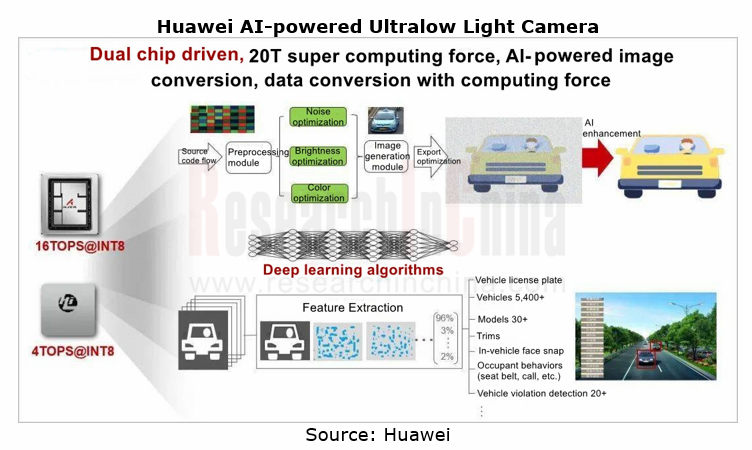
(2) Radar
Vendors are trying hard to improve the performance of roadside radars. Based on wide area radar front end and advanced data processing technologies, Hurys introduced a new-generation wide-area radar microwave intelligent perception system that offers more abundant, more diverse data; WAYV series ultra-long-range radars Muniu Technology launched in 2020 afford the longest detection range of 1,000 meters.
Moreover, 4D imaging radars are making their way into the roadside perception market. They provide all-round, three-dimensional, multi-dimensional monitoring and tracking of large intersections and highway scenarios, especially the holographic perception of CVIS at large complex intersections and in mixed traffic in cities. Vendors like Continental, Huawei and Oculii, which deploy roadside perception, have launched their 4D LiDARs.
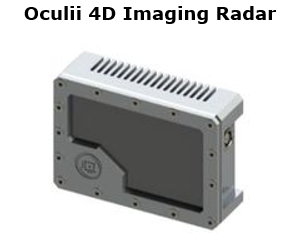
(3) LiDAR
LiDAR that can acquire high-precision three-dimensional information about targets enables e-fence control and some special capabilities (target filtering, customized communication, etc.) in designated areas.
Traditional roadside perception solution providers such as VanJee Technology, Changsha Intelligent Driving Institute Ltd. (CiDi) and China TransInfo Technology already unveil their roadside LiDAR products.
In March 2021, VanJee Technology managed to deploy its smart base stations that integrate with V2X roadside antenna and LiDAR in Xiongan Civic Center V2X Demonstration Project and High-speed Railway Hub Road Intelligence Project.
Also, automotive LiDAR vendors like RoboSense and Ouster have started a foray into the roadside perception field. In 2020, Ouster and LiangDao Intelligence together created a LiDAR-based roadside solution.
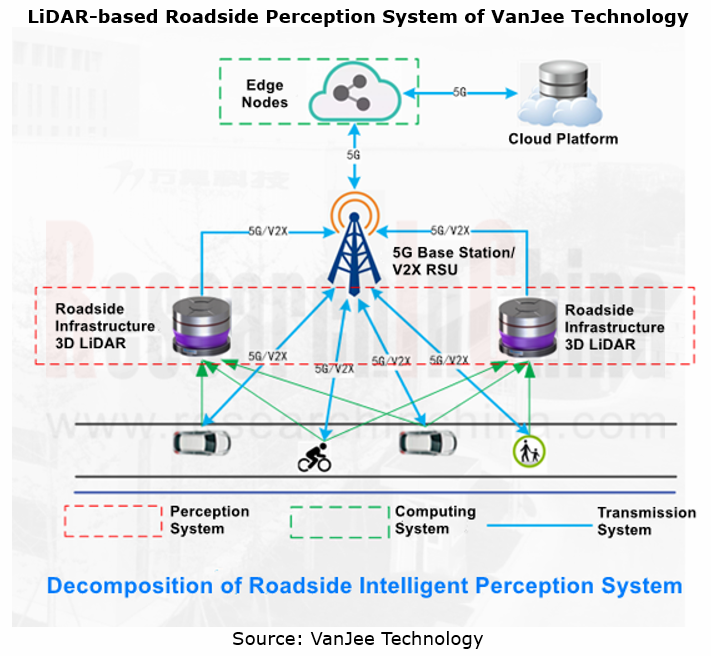
(4) Radar video all-in-one
Radar video all-in-ones that feature integrated design and unified installation and share power supplies, can save a lot of costs of materials and installation. The fronted deployment of perception fusion algorithms at the terminal end leads to a marked reduction in perception latency and computing load at the edge end; and the combination of merits of video and radar offers higher target detection accuracy.
Currently, roadside vision-based HD camera vendors like Dahua Technology and Hikvision and roadside radar vendors such as Raysun Radar, Hurys and DeGuRoon have introduced their radar video all-in-ones. Among them, in 2019 Oculii released 4D radar video all-in-one that uses Falcon, its first-generation point cloud imaging radar; in the second half of 2021, Raysun Radar unveiled IET6LRR, its new-generation radar video all-in-one that provides the maximum detection range of 425 meters.
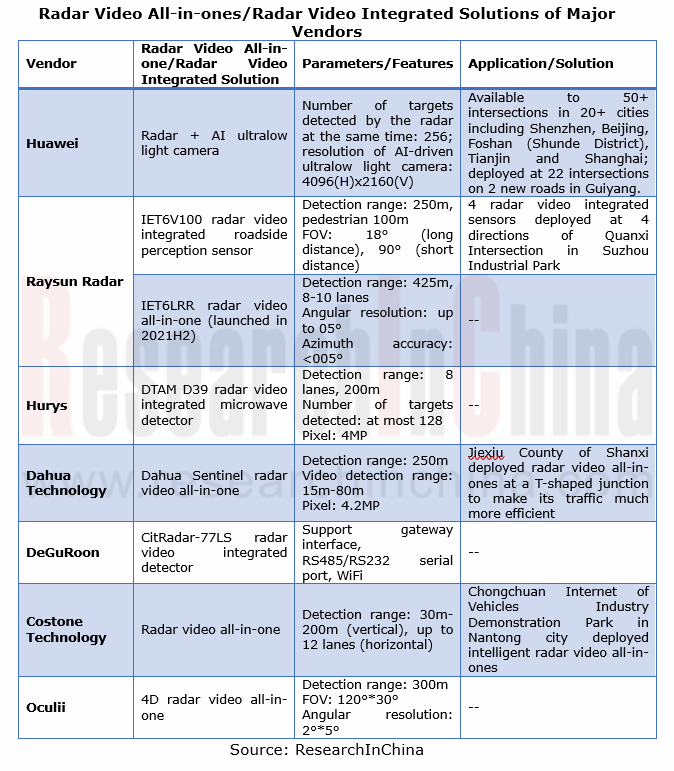
Huawei and Baidu have stepped into the field and launched “holographic perception intersection” solutions
Holographic perception is a foundation for the development of smart roads. It needs roadside perception equipment to provide comprehensive, high-quality, stable traffic data. Since 2000 Huawei, Baidu, OriginalTek and the Institute of Deep Perception Technology (IDPT), among others have rolled out their holographic perception solutions,
Huawei: in 2020 Huawei released the solution Holographic Perception Intersection 1.0; in March 2021, Huawei unveiled Holographic Perception Intersection 2.0, a combination of AI ultra-low light camera, radar, ITS800 edge computing node and intersection HD map, which is applicable to crossroads, T/X/Y-shaped intersections and super large intersections. Based on its holographic perception solutions, Huawei will create holographic road section solutions that enable convergence and access, analysis and communication capabilities at intersections and roadsides via edge computing units, and connect traffic signals and vehicle communication units to lay the foundation for CVIS services such as accurate public transit and driving assistance.
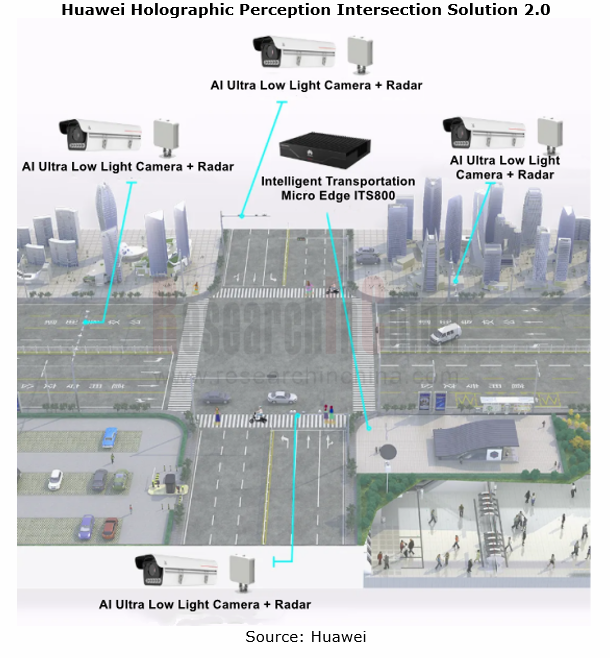
Baidu: Baidu ACE Intelligent Intersection Solution launched in March 2021 enables perception of all elements including road vehicles, roads, pedestrians, environments and traffic incidents, with perception and computing devices (camera, fisheye camera, LiDAR, edge computing unit, etc.) deployed at the roadside. The solution integrating with Baidu Map data delivers a data detection accuracy of over 97%. ACE Smart Intersection is an application of Baidu ACE Smart Traffic Engine (a full-stack intelligent transportation solution that integrates vehicle, infrastructure and pedestrian) in the intersection scenario.
In Baidu ACE Intelligent Intersection Solution, devices like camera, LiDAR, communication equipment and edge computing unit are customized by Baidu with its ecological partners.
IDPT: the deep fusion of raw data from cameras, LiDARs, radars, and radar video all-in-ones enables 360° image-level holographic perception around the clock in all weather conditions, offering the longest detection range of up to 500m and more reliable data for urban intersections.
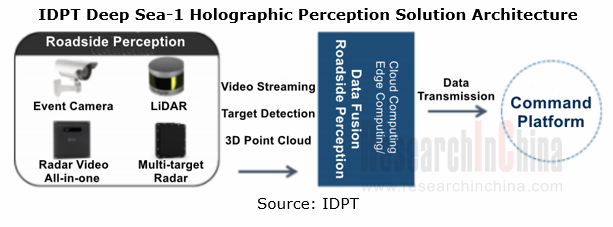
In addition, Hikailink Technology achieves holographic intersection perception with radar, camera, and image-level solid-state LiDAR; OriginalTek deployed BotEye? holographic perception devices in the test park where the 2020 C-V2X Cross-industry & Large-scale Pilot Plugfest was held.
The roadside perception market will be worth RMB20 billion in 2025
Intelligent roadside perception will firstly cover highways and urban intersections. The official statistics show that China has 149,600km highways in all, with the overall density of road networks averaging 6.1km/km2 and the total urban construction areas reaching 21,000 km2 in 36 major cities.
On our estimate, China's intelligent roadside perception equipment market (including RSU, camera, radar, LiDAR, and radar video all-in-one) will be valued at RMB20 billion or so in 2025. Camera and radar will be still mainstream devices for roadside perception, while radar video all-in-one and LiDAR will gather pace.
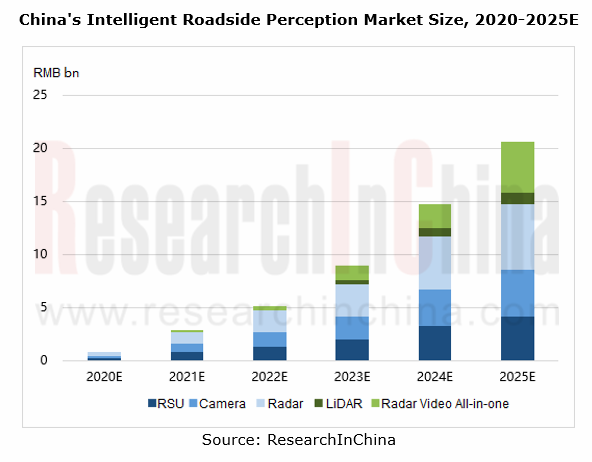
Smart Road-Roadside Perception Industry Report, 2021 highlights the following:
 Smart road industry (favorable policies, industry standards, industrial planning);
Smart road industry (favorable policies, industry standards, industrial planning);
 Intelligent roadside perception market (size, pattern);
Intelligent roadside perception market (size, pattern);
 Status quo and trends of key technologies (HD camera, radar, radar video all-in-one, LiDAR, multi-sensor fusion, etc.);
Status quo and trends of key technologies (HD camera, radar, radar video all-in-one, LiDAR, multi-sensor fusion, etc.);
 Deployment cases of roadside perception devices on highways and at urban intersections;
Deployment cases of roadside perception devices on highways and at urban intersections;
 Major roadside perception system integrators and equipment suppliers.
Major roadside perception system integrators and equipment suppliers.
Automotive 4D Radar Industry Research Report 2025
4D radar research: From "optional" to "essential," 4D radar's share will exceed 50% by 2030.
1. 4D imaging radar has transformed from an "optional" to a "must-have" sensor.
4D radar adds the detecti...
China Automotive Multimodal Interaction Development Research Report, 2025
Research on Automotive Multimodal Interaction: The Interaction Evolution of L1~L4 Cockpits
ResearchInChina has released the "China Automotive Multimodal Interaction Development Research Report, 2025"...
Automotive Vision Industry Report, 2025
Automotive Vision Research: Average Camera Installation per Vehicle Reaches 5.2 Units, and Front-View Tricam Installation Exceeds 1.2 Million Sets.
From January to September 2025, the total installa...
Automotive Infrared Night Vision System Research Report, 2025
Automotive night vision research: The rise of infrared AEB, with automotive infrared night vision experiencing a 384.7% year-on-year increase from January to September.
From January to September 2025...
New Energy Vehicle Cross-Domain (Electric Drive System and Powertrain Domain) Integration Trend Report 2025-2026
Electric Drive and Powertrain Domain Research: New technologies such as three-motor four-wheel drive, drive-brake integration, and corner modules are being rapidly installed in vehicles.
Electric dri...
Analysis on Desay SV and Joyson Electronic's Electrification, Connectivity, Intelligence and Sharing, 2025
Research on Desay SV and Joyson Electronic: Who is the No.1 Intelligent Supplier?
Both Desay SV and Joyson Electronic are leading domestic suppliers in automotive intelligence. "Analysis on Desay SV ...
OEMs and Tier 1 Suppliers' Cost Reduction and Efficiency Enhancement Strategy Analysis Report, 2025
ResearchInChina released the "OEMs and Tier 1 Suppliers' Cost Reduction and Efficiency Enhancement Strategy Analysis Report, 2025", summarizing hundreds of cost reduction strategies to provide referen...
Automotive Fixed Panoramic Sunroof and Smart Roof Research Report, 2025
With the intelligent application of car roofs as the core, this report systematically sorts out a series of new products such as fixed panoramic sunroof/openable sunroof, ceiling screen, roof ambient ...
Automotive-Grade Power Semiconductor and Module (SiC, GaN) Industry Research Report, 2025
SiC/GaN Research: Sales volume of 800V+ architecture-based vehicles will increase more than 10 times, and hybrid carbon (SiC+IGBT) power modules are rapidly being deployed in vehicles.
Sales volume o...
Cockpit Agent Engineering Research Report, 2025
Cockpit Agent Engineering Research: Breakthrough from Digital AI to Physical AI
Cockpit Agent Engineering Research Report, 2025 starts with the status quo of cockpit agents, summarizes the technical ...
Prospective Study on L3 Intelligent Driving Technology of OEMs and Tier 1 Suppliers, 2025
L3 Research: The Window of Opportunity Has Arrived - Eight Trends in L3 Layout of OEMs and Tier 1 Suppliers
Through in-depth research on 15 OEMs (including 8 Chinese and 7 foreign OEMs) and 9 Tier 1 ...
China Commercial Vehicle IoV and Intelligent Cockpit Industry Research Report 2025
Commercial Vehicle IoV and Cockpit Research: The Third Wave of Passenger Car/Commercial Vehicle Technology Integration Arrives, and T-Box Integrates e-Call and 15.6-inch for Vehicles
I. The third wav...
Intelligent Vehicle Electronic and Electrical Architecture (EEA) and Technology Supply Chain Construction Strategy Research Report, 2025
E/E Architecture Research: 24 OEMs Deploy Innovative Products from Platform Architectures to Technical Selling Points
According to statistics from ResearchInChina, 802,000 passenger cars with domain...
Research Report on Intelligent Vehicle Cross-Domain Integration Strategies and Innovative Function Scenarios, 2025
Cross-Domain Integration Strategy Research: Automakers' Competition Extends to Cross-Domain Innovative Function Scenarios such as Cockpit-Driving, Powertrain, and Chassis
Cross-domain integration of ...
China Autonomous Driving Data Closed Loop Research Report, 2025
Data Closed-Loop Research: Synthetic Data Accounts for Over 50%, Full-process Automated Toolchain Gradually Implemented
Key Points:From 2023 to 2025, the proportion of synthetic data increased from 2...
Automotive Glass and Smart Glass Research Report, 2025
Automotive Glass Report: Dimmable Glass Offers Active Mode, Penetration Rate Expected to Reach 10% by 2030
ResearchInChina releases the Automotive Glass and Smart Glass Research Report, 2025. This r...
Passenger Car Brake-by-Wire (BBW) Research Report, 2025
Brake-by-Wire: EHB to Be Installed in 12 Million Vehicles in 2025
1. EHB Have Been Installed in over 10 Million Vehicles, A Figure to Hit 12 Million in 2025.
In 2024, the brake-by-wire, Electro-Hydr...
Autonomous Driving Domain Controller and Central Computing Unit (CCU) Industry Report, 2025
Research on Autonomous Driving Domain Controllers: Monthly Penetration Rate Exceeded 30% for the First Time, and 700T+ Ultrahigh-compute Domain Controller Products Are Rapidly Installed in Vehicles
L...